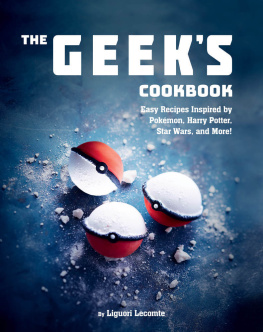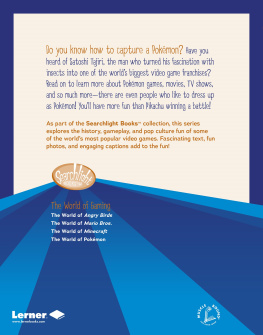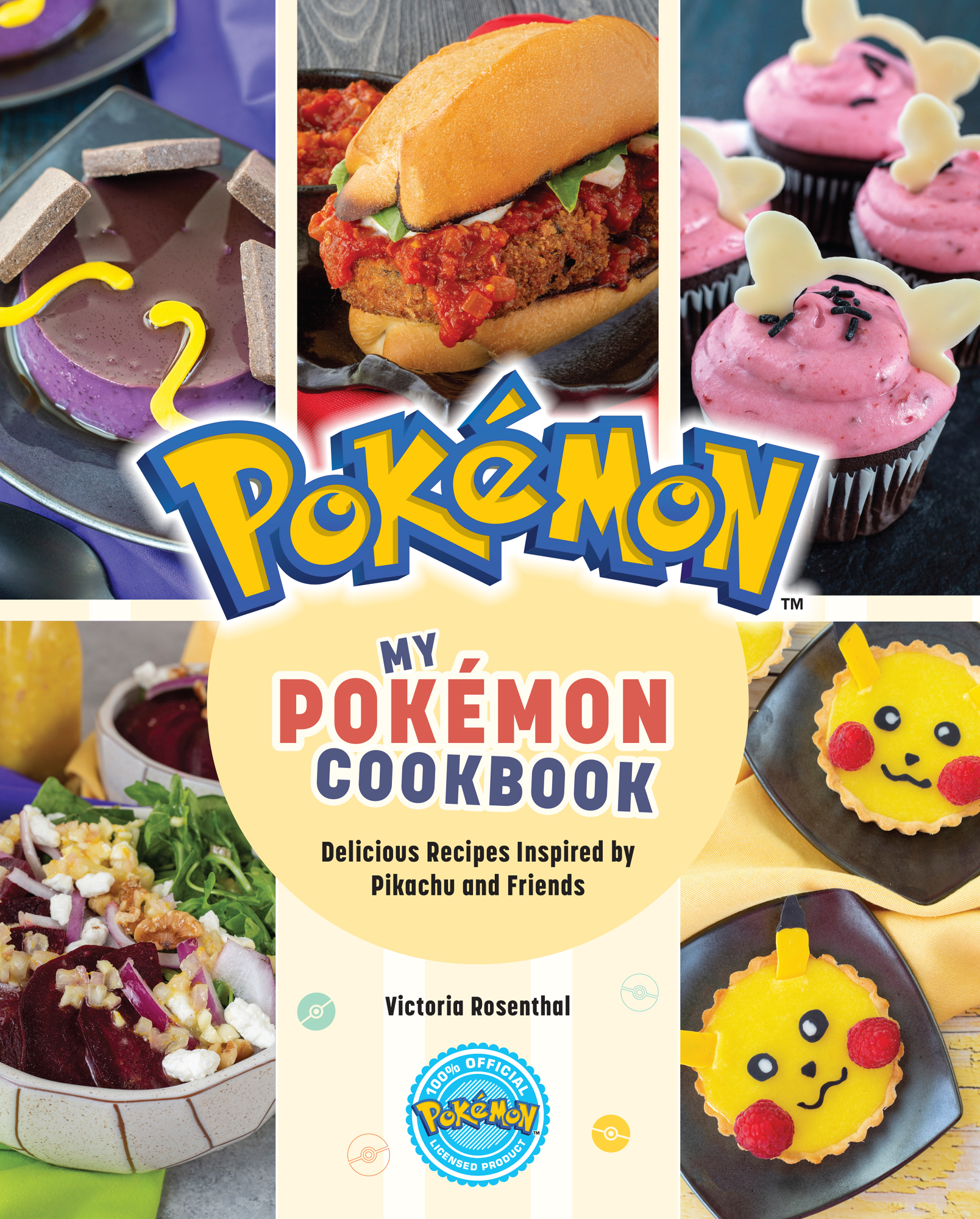Contents
Guide
Pokmon
My Pokmon Cookbook
Delicious Recipes Inspired by Pikachu and Friends
Victoria Rosenthal
Introduction
The world of Pokmon is a story of adventure, friendship, and being the very best you can be. Although the goal is typically about forming the strongest team of Pokmon you can and defeating the reigning champion to claim the title for yourself, being the new Pokmon champion isnt possible without forming friendships and true bonds on the way. The charm of the journey is universal.
The goal of this cookbook is to take that love of Pokmon that so many people share and extend it to the wonderful world of cuisine. These recipes include all sorts of drinks, desserts, and other delicious dishes that celebrate and cherish all the amazing varieties of Pokmon out there, taking inspiration from all the different types of Pokmon to think of great ways to get in the kitchen and get cooking. We can come up with Fire-type dishes that are spicy and warm you up. Electric-type dishes full of sour elements that bring a spark to your plate. Ground-type dishes that are filling and dense, and eating too much may leave you, well, grounded for a time. Each and every known type is represented in this cookbook, and I hope you enjoy the characteristics that show themselves in the meals they are tied to!
All of the recipes in this book are family friendly. Pokmon has fans of all ages, and another goal of this book is to bring the family into the kitchen and combine a love of Pokmon with a love of food. This book provides fun ways to bring those less familiar with culinary adventures into the kitchen. There are a few more complicated recipes that will require extra care and a helping hand, but there are also plenty of meals that are easily approachable for anyone new to cooking.
So lets get cooking! There are lots of fun treats and tasty dishes to enjoy. Now you can cook them all and perhaps even make some friends along the way.
Ingredient Guide
Aburaage are thinly sliced, deep-fried tofu pockets used in Japanese cuisine.
Blue spirulina is an extract from spirulina, a type of microalgae. For the recipes in this book, you will want to use the powder variety of this ingredient.
Butterfly pea flowers are dried flowers that grow in Southeast Asia. The flower is dehydrated and commonly used for tea. It is used to dye things a bright blue color.
Calabrian chile peppers are smoky chile peppers grown in Italy. They have a Scoville scale rating between 25,000 and 40,000 SHU.
Chinese five-spice powder is a combination of cinnamon, Szechuan peppercorns, star anise, fennel seeds, and cloves. It can be stored in the pantry for up to a year, but keep in mind that spices will lose their flavor the longer they are stored.
Condensed milk is milk that has been gently heated, had 60 percent of the water removed, been mixed with sugar, and canned. This is an extremely thick, caramelized sweetened milk. It is typically found in cans that can be stored in the pantry for about a year. Once opened, it must be refrigerated and used within 2 weeks.
Evaporated milk is milk that has been gently heated and had 60 percent of the water removed to make a dense, creamy milk. It is found in cans that can be stored in a pantry for about 6 months. Once opened, it must be refrigerated and used within 5 days.
Gochujang is a Korean thick chile paste that contains red chile peppers, sticky rice, fermented soybeans, and sweeteners. Heat levels of gochujang can vary and are displayed on the container with a spice indicator. Once gochujang is opened, it must be stored in an airtight container in the refrigerator.
Hoisin sauce is a sweet, thick sauce used in Chinese cuisine, especially BBQ, made from fermented soybean and Chinese five-spice powder. It can be used for cooking or just as a dipping sauce. Hoisin sauce can be stored in the pantry until opened. Once opened, store in a refrigerator.
Kashmiri chile powder is made from the Kashmiri chile that has been dried and ground. Kashmiri chile has a mild heat with a vibrant red coloring. A good substitute for Kashmiri chile powder includes paprika or another mild chile.
Miso is a Japanese paste made from fermented soybeans. Miso comes in several varieties including white (the mildest flavor) and red (allowed to age for longer, making it saltier and with a stronger flavor). Miso can be stored in an airtight container in the refrigerator.
Nori is a dried edible sheet of seaweed used in Japanese cuisine. It is most commonly used to wrap sushi rolls. Nori can be stored in a cool pantry.
Plantains are related to bananas but are much starchier and cant be eaten raw. Unripe plantains will be green in color. As they ripen, they turn yellow (medium) and eventually black (fully ripe).
Rice paper is a super thin wrapper made from rice and used in Vietnamese cuisine. The sheets are dry and need to be rehydrated before use as a wrapper.
Strawberry powder is dehydrated strawberries that have been blended into a powder. You can find this product easily online, or you can use dehydrated strawberries that you grind into a fine powder with a food processor.
Thai basil is an herb with purple stems and green leaves used in Southeast Asian cuisine. It has a licorice-like and mildly spicy flavor. It is a slightly sturdier herb than Italian basil and is more stable at higher cooking temperatures. Thai basil can be substituted with any type of basil, but it will have a different flavor profile.
Tonkatsu sauce is a thick, sweet sauce used in Japanese cuisine. It can be stored in the pantry. Once opened, it can be stored in the refrigerator in an airtight container for about two months.
Umeboshi are pickled plums used in Japanese cuisine. They are extremely sour and salty.
Vanilla Beans are commonly used to flavor recipes by slicing them open and scraping the insides. You can substitute 1 tablespoon of vanilla extract or vanilla paste per bean.
Vital wheat gluten is wheat flour that has had most of its starch removed, leaving the wheat proteins behind. The protein content is between 75 and 85 percent. Adding it to a dough will yield a much more elastic and chewier texture.
Allergy Notes
Just like how all Pokmon have their own strengths and weaknesses, people have their own personal tastes and food restrictions. It is important when cooking that you are ready to make adjustments in order to avoid any food allergies. Keep in mind restrictions and accommodations for yourself and any guests you may be feeding. Its always fine to make adjustments to fit the recipes to your own needs.
Adapting to Vegetarian Diets
Most of the recipes in this book are vegetarian or vegan friendly. The remaining two recipes can be adapted to your dietary needs. Swap out proteins with your favorite grilled vegetable or meat substitute. This will affect the cooking times, so plan ahead. Many of the vegetarian dishes can also be adjusted to become vegan by simply using dairy or honey alternatives.











